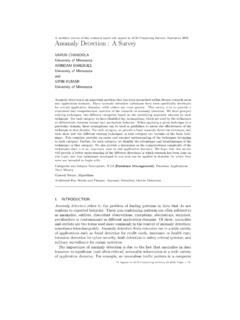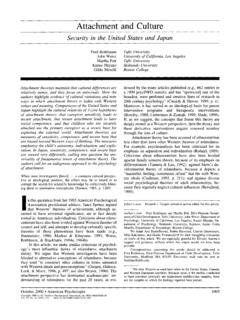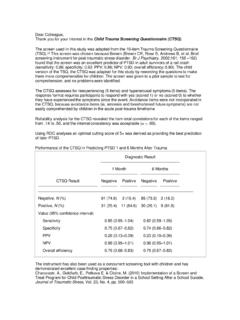Transcription of Bandura and the Bobo Doll 1 Running head: BANDURA AND …
1 BANDURA and the bobo doll 1 Running head: BANDURA AND THE bobo doll BANDURA , Ross, and Ross: Observational Learning and the bobo doll Anthony R. Artino, Jr. University of Connecticut January 1, 2007 BANDURA and the bobo doll 2 BANDURA , Ross, and Ross: Observational Learning and the bobo doll Since the publication of their seminal article entitled, Transmission of Aggression Through Imitation of Aggressive Models ( BANDURA , Ross, & Ross, 1961), the work of Albert BANDURA and his co-authors has had an immeasurable impact on the field of psychology, in general, and educational psychology, more specifically. The purpose of this report is to describe, in brief, Albert BANDURA s major contributions to the field of educational psychology. Although BANDURA s contributions are vast by any measure, this paper focuses on his work with social modeling and observational learning. The report includes a short biography of BANDURA s academic life, followed by an overview of the research article that launched his prolific career and a review of his social learning theory.
2 The paper ends with a discussion of BANDURA s enduring legacy, including a summary of his major contributions to the field of educational psychology and an abbreviated list of the doctoral students he has trained and colleagues he has influenced. Albert BANDURA s Abridged Biography Albert BANDURA was born on December 4, 1925, in Mundare, a village in northern Alberta, Canada. He was the youngest child, and only boy, among six children of immigrant parents from Eastern Europe (Zimmerman & Schunk, 2003). As a young student, BANDURA s primary and secondary education took place at the one and only school in town, with very limited resources. As a result of this meager academic environment, BANDURA realized early on that learning is largely a social and self-directed endeavor. In his words, the content of most textbooks is perishable, but the tools of self-directedness serve one well over time ( BANDURA , as BANDURA and the bobo doll 3cited in Pajares, 2004a, 3).
3 Interestingly, this sentiment would reappear in BANDURA s later research into self-regulation and its influence on lifelong learning. Following high school, BANDURA moved west to attend the University of British Columbia in Vancouver, Canada. Stumbling upon psychology more by chance than by choice (Pajares, 2004a), BANDURA excelled in college and, after only three years of study, received his degree in psychology in 1949. On the advice of his undergraduate adviser, BANDURA then decided to head south to the United States for his graduate studies at the University of Iowa. At the time, as is still the case today, the psychology program at the University of Iowa was considered one of the best in North America (Kendler, 1991). While at Iowa, BANDURA was mentored by numerous acclaimed faculty, including Kenneth Spence, Kurt Lewin, and Arthur Benton, his academic adviser (see Table 1 for summary of BANDURA s professional genealogy).
4 Table 1 Albert BANDURA 's Professional Genealogy (adapted from Pajares, 2004a) Adviser Advisee University Year *William James James Rowland Angell Harvard University 1893 James Rowland Angell John Watson University of Chicago 1903 John Watson Karl Spencer Lashley Johns Hopkins University 1914 Karl Spencer Lashley Carney Landis University of Minnesota 1924 Carney Landis Arthur Benton Columbia University 1935 Arthur Benton Albert BANDURA University of Iowa 1952 *Note. William James is considered by many to be the Father of American psychology (Pajares, 2003). BANDURA and the bobo doll 4 After only a few years at Iowa, BANDURA received his degree in 1951 and his degree in clinical psychology in 1952. Following a postdoctoral internship at the Wichita Guidance Center, BANDURA joined the faculty of the Department of Psychology at Stanford University in 1953, where he still resides today after more than 50 years of productive scholarly activity (Pajares, 2004a; Zimmerman & Schunk, 2003).
5 BANDURA , Ross, and Ross and the Legendary bobo doll Challenging Prominent Theories of the Day When BANDURA first arrived at Stanford, Robert Sears, the Chair of the Department, was exploring the familial antecedents of social behavior in children. Influenced by this work, BANDURA began a program of research on social learning and aggression in collaboration with Richard Walters, his first doctoral student (Pajares, 2004a). At that time, ideas about aggression in young children were dominated by the Freudian view that such behavior was the product of intrapsychic forces operating largely unconsciously. Students aggression on the playground or in school was seen as a recurring expression of underlying impulses requiring release in minimally detrimental ways (Zimmerman & Schunk, 2003, p. 440). Furthermore, the Freudian theory of catharsis stated that modeled violence would drain observers aggressive drives and reduce subsequent aggressive behavior.
6 Citing this Freudian view, television executives at the time were defending increasingly violent programming as socially beneficial since, in theory, violent programs would help drain viewers aggressive drives thereby reducing aggressive tendencies (Pajares, 2004a; Zimmerman & Schunk, 2003). The bobo doll Experiment With this scholarly and political landscape as a backdrop, BANDURA began a program of research with Dorrie and Sheila Ross on social modeling involving the now legendary inflatable BANDURA and the bobo doll 5plastic bobo doll . In their 1961 experiment the first of many using the bobo doll paradigm 24 preschool children were assigned to one of three conditions. One experimental group observed adult models playing aggressively with an inflatable plastic bobo doll ; a second group observed adult models playing non-aggressively with a bobo doll ; and subjects in the control group had no exposure to the models ( BANDURA et al .)
7 , 1961). Additionally, half the children in the experimental conditions observed same-sex models and half viewed models of the opposite sex. Subjects were then assessed for the amount of imitative as well as nonimitative aggression performed in a new, generalized situation in the absence of the models ( BANDURA et al ., 1961). Results revealed that children exposed to aggressive models reproduced considerably more aggressive behaviors resembling that of the models, and that their mean aggression scores were significantly higher than subjects in the nonaggressive and control groups. Furthermore, children in the aggressive condition exhibited significantly more partially imitative and nonimitative aggressive behavior and were generally less inhibited in their behavior than subjects in the nonaggressive condition ( BANDURA el al., 1961, p. 582). Finally, the extent to which children imitated the model was differentially influenced by the sex of the model, with boys showing more aggression than girls following exposure to the male model.
8 Based on these results, BANDURA and his co-authors questioned much of the existing research on social learning which was focused on the shaping of new behaviors through rewards and punishments. While these strict behaviorist views necessitated the reinforcement of emitted behaviors, BANDURA s findings suggested that observation of cues produced by the behavior of others is one effective means of eliciting certain forms of responses for which the original probability is very low or zero ( BANDURA et al ., 1961, p. 580). In other words, observational learning can occur in the absence of reinforcements to the observers, thereby speeding up the BANDURA and the bobo doll 6acquisition of new behaviors. At the time of their experiment, these ideas were in express disagreement with accepted views, which stated that learning is a result of direct reinforcement (Skinner, 1938; Zimmerman & Schunk, 2003). Following their initial bobo doll experiment, BANDURA , Ross, and Ross conducted a similar study which sought to determine the extent to which film-mediated aggressive models could serve as sources of imitative behavior ( BANDURA , Ross, & Ross, 1963).
9 This follow-up study, entitled Imitation of Film-Mediated Aggressive Models, provided additional evidence to support their theoretical account of observational learning. In general, their results revealed that filmed aggression increased aggressive reactions in children. In the words of the authors, subjects who viewed the aggressive human and cartoon models on film exhibited nearly twice as much aggression than did subjects in the control group who were not exposed to the aggressive film content ( BANDURA et al ., 1963, p. 9). Taken together, results from the two bobo doll experiments provided strong evidence that learning can occur vicariously and without any reinforcers delivered either to the model or to the observer ( BANDURA et al ., 1963, p. 11). Furthermore, the experimental findings helped debunk the Freudian concept of catharsis; revealing instead the power of modeled aggression (both live and through television or film) on children s aggressive tendencies (Zimmerman & Schunk, 2003).
10 Theoretical Contributions Based, in part, on findings from the classic bobo doll experiments, BANDURA began developing the theoretical underpinnings of his social learning theory, to include the prominent role of observational learning and social modeling in human learning and motivation. As BANDURA (1989) noted, observational learning is governed by four component subfunctions (p. BANDURA and the bobo doll 723). These subfunctions, or processes, are necessary before an individual can successfully model another. The processes include attention, retention, motor reproduction, and motivation. Attentional processes determine what aspects of modeled behavior individuals observe and what information they extract from that behavior. Students cannot learn a new skill if they do not pay close attention to the critical features of the modeled behavior and less attention to the irrelevant parts. For teachers, this point becomes critical because often times they must modify or alter the behavior they model to compensate for the attentional limitations of their students ( BANDURA , 1989).














